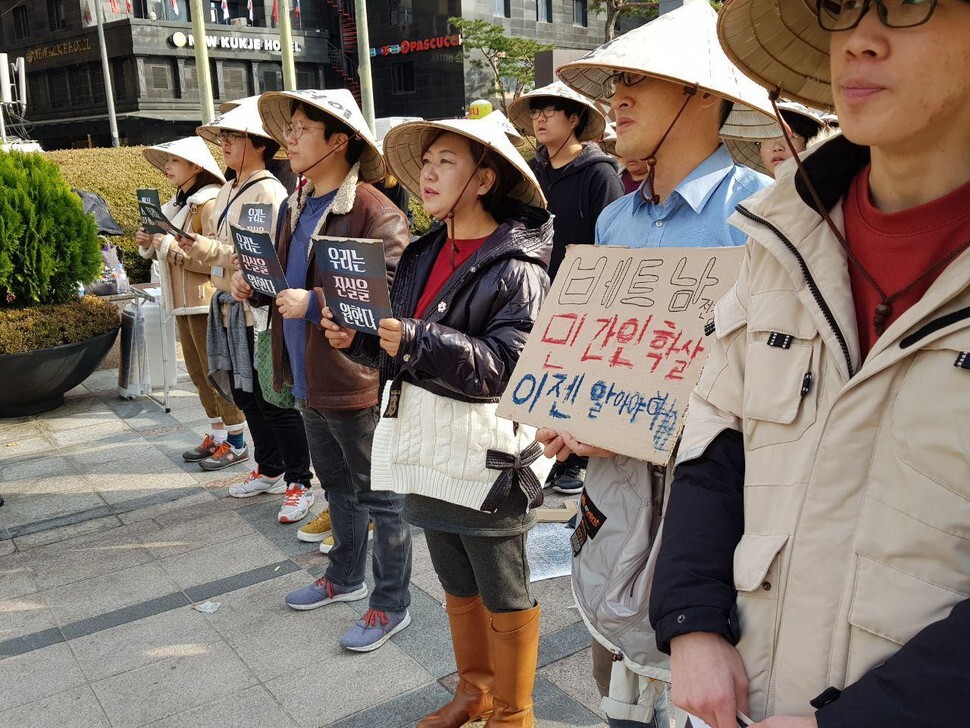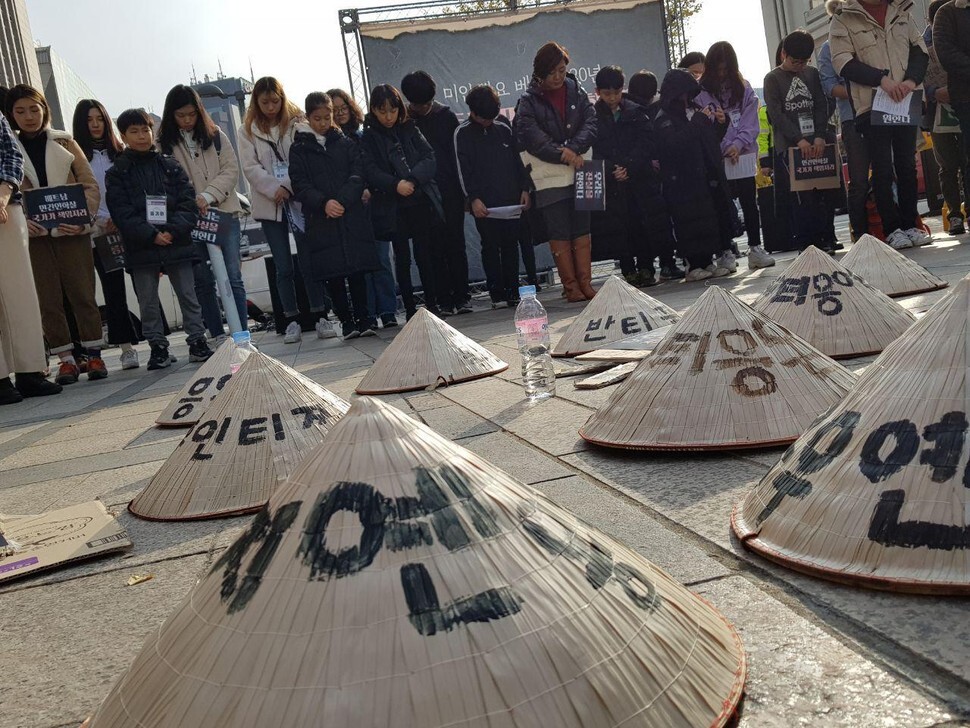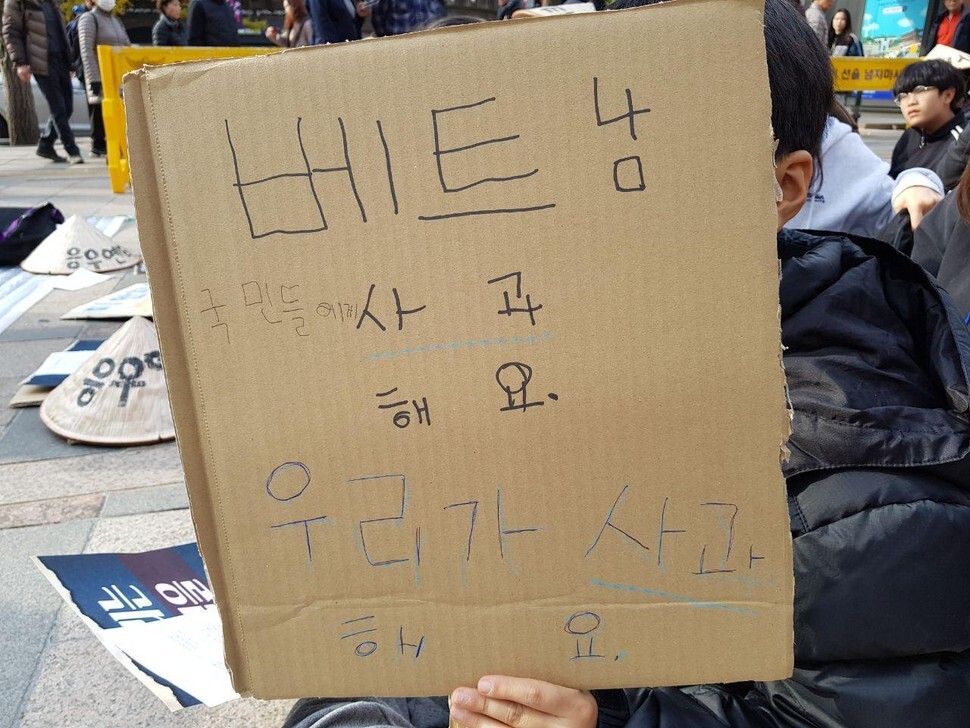hankyoreh
Links to other country sites 다른 나라 사이트 링크
Civic groups demand S. Korean government take responsibility for Vietnam War civilian massacres

On the afternoon of Nov. 23, 60 Vietnamese conical hats, known as non la, were lined up on the sidewalk in front of the Seoul Finance Center. Various names were written on the non la: Van Thinh, Nguyen Tipi, Nguyen Khui, Khao Thi Sok, Van Suen, and so forth – the names of civilians massacred by South Korean troops at Ha My Village in Vietnam in 1968.
“We intend to hand over the public square to the victims. Our desire is for the people who never had the opportunity to stand here, who were forgotten by us, who haven’t been remembered by the Republic of Korea, to be with us together in this place,” said Shin Min-ju, head of Below the Lotus Flower, an organization committed to raising awareness about civilian massacres perpetrated by South Korean soldiers during the Vietnam War. At that point, the 40 demonstrators paid a silent tribute to the names on the non la in the square.
This was one vignette of a demonstration titled “Civilian Massacres in Vietnam: Time to Hold the State Responsible” that was organized by 16 groups, including Below the Lotus Flower and the Korea-Vietnam Peace Foundation. During the event, demonstrators called on the South Korean government to take responsibility by offering an apology and compensation to the victims of the civilian massacres in Vietnam, to conduct a thorough investigation of the massacres, to oblige the National Intelligence Service (NIS) to release documents from an investigation into massacres at the villages of Phong Nhi and Phong Nhat, and to add a full account of the massacres to school textbooks.
These were some of the slogans chanted by the demonstrators: “We want the truth.” “The state should take responsibility for the civilian massacres.” “The NIS must quickly release its information.”
According to Below the Lotus Flower, South Korean troops deployed to Vietnam beginning in 1964 were responsible for massacres in villages in the provinces of Quang Nam, Quang Ngai, Binh Dinh, Phu Yen, and Khanh Hoa in which more than 9,000 civilians were killed. The issue was brought to the attention of South Koreans by the Hankyoreh in 1999, leading to the “I’m Sorry, Vietnam” movement, now in its 20th year.

“Given South Korea’s attitude toward the civilian massacres in the Vietnam War, we may not be in any position to criticize Japan for refusing to address the comfort women issue. I hope the South Korean government won’t end up acting like the Japanese government,” said Koh Gyeong-tae, director of 22nd Century Media. Koh was a Hankyoreh reporter who wrote about the massacres in 1999.
Kim Na-mu, a member of the steering committee for Below the Lotus Flower, was born in 1999, when the civilian massacres were first reported in South Korea. “Twenty years have passed since then, enough time for me to become an adult, but the government is still refusing to mention the civilian massacres on the pretext that it has no corroborating documents. Furthermore, our presidents haven’t gone any further than expressing their ‘regret’ and describing the massacres as ‘tragic,’” Kim said.
NIS’ refusal to disclose key documents related to massacresThe NIS continues to face criticism for refusing to disclose documents from an investigation of the civilian massacres at Phong Nhi and Phong Nhat.
“On Feb. 12, 1968, the Blue Dragon Division [South Korean 2nd Marine Division] carried out an operation at the villages of Phong Nhi and Phong Nhat in which more than 70 civilians were killed. We submitted a freedom of information request to the NIS in 2016 asking it to release the related documents. The courts ordered the documents released in July 2018, but the NIS is still refusing to do so, on the grounds that the South Korean government hasn’t developed a strategy for responding to a potential lawsuit by Vietnamese victims. There’s no consideration for the victims’ point of view,” said Lim Jae-sung, an attorney for MINBYUN-Lawyers for a Democratic Society.

Another issue is that the civilian massacres aren’t being properly dealt with at schools. “In 2016, five out of six government-issued textbooks made mention of the civilian massacres during the Vietnam War, but the fact is that students are still being taught that [the Vietnam War] was a war that contributed to our economic development. American textbooks also cover American mistakes, such as the My Lai massacre [a major massacre of Vietnamese civilians carried out by the US army in 1968]. Students want to learn about South Korea’s mistakes and problems, too,” said Kim Jin-yeong, an activist with Below the Lotus Flower.
“I want to learn not just about Korea’s economic development but also about the painful parts of our history at school,” said Kim Min-chae, 13, during an open mic segment.
The demonstrators were united in their call for the government to take proactive steps to investigate the massacres.
“When my friends and I were discussing the civilian massacres, we were really sad to see that people our age had been among those killed. I think that the government needs to apologize to the victims’ families and make an effort to uncover the truth,” said Yun Ju-ho, 12.
“The government ought to acknowledge what happened and be transparent about it. Koreans know as well as anyone the horrible reality of war. It’s hypocritical to make demands of Japan without showing any remorse for Vietnam,” said Lee Hye-jeong, 35.
Anti-protest demonstrators brandish S. Korean, American flagsWhile the demonstration was taking place, a group of elderly people carrying Korean flags and American flags made ugly gestures at the speakers and demonstrators and also complained to the police.
“Whenever we hold a demonstration, people in marine corps hats give us a piece of their mind. I want to tell them they aren’t to blame and that they’re also victims who were mobilized by state violence,” said Lee Ji-u, 20.
By Jeon Gwang-joon, staff reporter
Please direct comments or questions to [english@hani.co.kr]

Editorial・opinion
![[Column] Season 2 of special prosecutor probe may be coming to Korea soon [Column] Season 2 of special prosecutor probe may be coming to Korea soon](https://flexible.img.hani.co.kr/flexible/normal/500/300/imgdb/original/2024/0426/3317141030699447.jpg) [Column] Season 2 of special prosecutor probe may be coming to Korea soon
[Column] Season 2 of special prosecutor probe may be coming to Korea soon![[Column] Park Geun-hye déjà vu in Yoon Suk-yeol [Column] Park Geun-hye déjà vu in Yoon Suk-yeol](https://flexible.img.hani.co.kr/flexible/normal/500/300/imgdb/original/2024/0424/651713945113788.jpg) [Column] Park Geun-hye déjà vu in Yoon Suk-yeol
[Column] Park Geun-hye déjà vu in Yoon Suk-yeol- [Editorial] New weight of N. Korea’s nuclear threats makes dialogue all the more urgent
- [Guest essay] The real reason Korea’s new right wants to dub Rhee a founding father
- [Column] ‘Choson’: Is it time we start referring to N. Korea in its own terms?
- [Editorial] Japan’s rewriting of history with Korea has gone too far
- [Column] The president’s questionable capacity for dialogue
- [Column] Are chaebol firms just pizza pies for families to divvy up as they please?
- [Column] Has Korea, too, crossed the Rubicon on China?
- [Correspondent’s column] In Japan’s alliance with US, echoes of its past alliances with UK
Most viewed articles
- 1AI is catching up with humans at a ‘shocking’ rate
- 2‘We must say no’: Seoul defense chief on Korean, USFK involvement in hypothetical Taiwan crisis
- 3[Column] Season 2 of special prosecutor probe may be coming to Korea soon
- 4Division commander ordered troops to enter raging flood waters before Marine died, survivor says
- 5Is Japan about to snatch control of Line messenger from Korea’s Naver?
- 6Korea protests Japanese PM’s offering at war-linked Yasukuni Shrine
- 7Is N. Korea threatening to test nukes in response to possible new US-led sanctions body?
- 8[Guest essay] The real reason Korea’s new right wants to dub Rhee a founding father
- 9One Hyundai worker suffers through 16 piecemeal contracts in 23 months
- 10[Photo] Migrant workers rally for labor rights